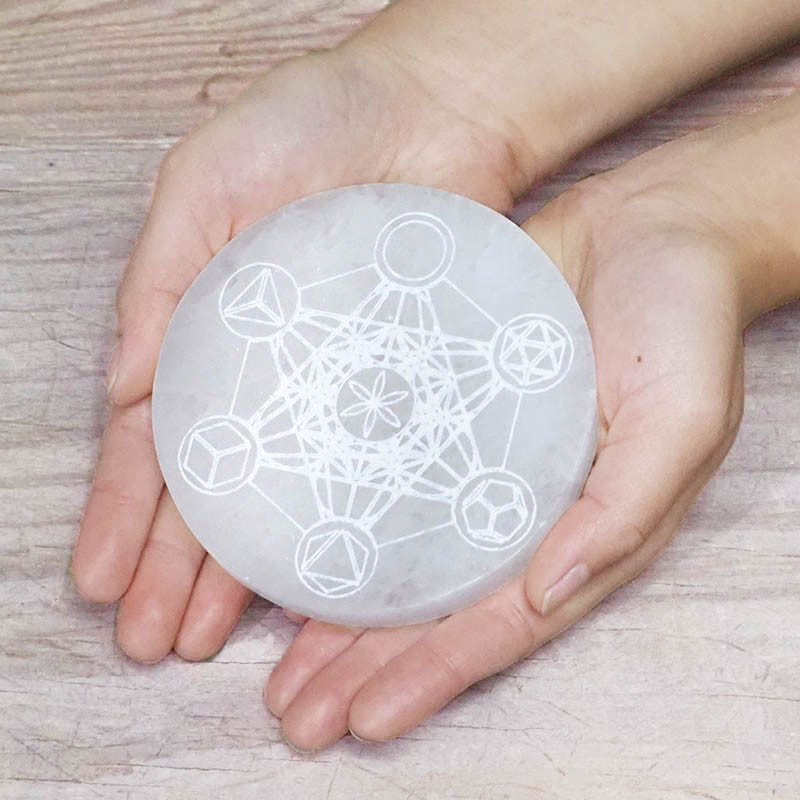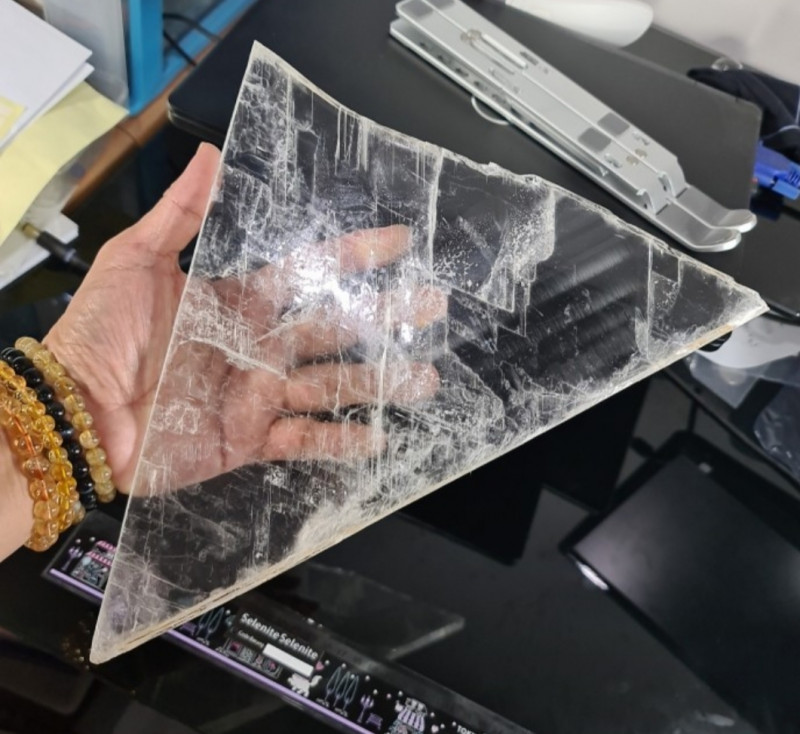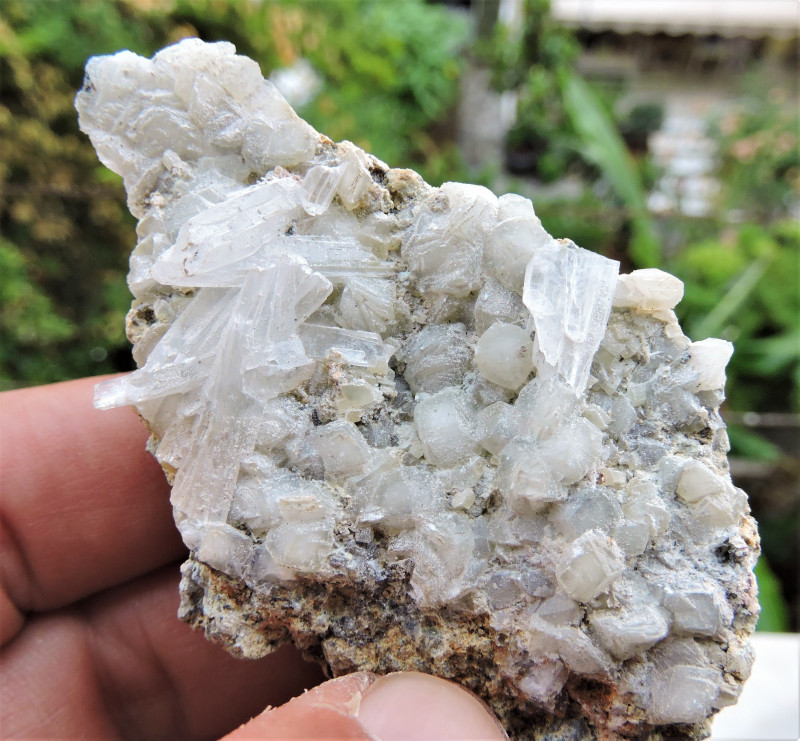
石膏宝石:特性、含义、价值和信息
 石膏宝石是一种柔软的浅色硫酸盐,以形成各种迷人的晶体形状而闻名,是世界上最古老的建筑材料之一。事实上,你家里的墙壁很可能就含有石膏!
石膏宝石是一种柔软的浅色硫酸盐,以形成各种迷人的晶体形状而闻名,是世界上最古老的建筑材料之一。事实上,你家里的墙壁很可能就含有石膏!
石膏是岩石还是矿物?两者都是!没错,石膏矿物晶体和岩体(称为石膏岩)都存在。它也是最常见的天然硫酸盐矿物。
如果您熟悉莫氏矿物硬度表,您可能会认出石膏是标准的二级宝石。水晶疗愈爱好者可能知道石膏中含有一种广受欢迎的清洁成分——透石膏。
但石膏还有更多用途,使它成为一种独特的晶体,并成为我们现代生活的重要组成部分!
读完本指南,您将了解石膏的所有特性、用途、价格、品种等等。首先,我们来了解一下石膏宝石的基础知识。

什么是石膏石?
半宝石石膏通常呈白色或灰白色,但杂质会使其呈现不同的颜色。石膏晶体的形状也多种多样,从华丽的玫瑰花结到巨大的柱状。有些甚至拥有“水般”的透明度。
这种矿物的吸引力部分在于其易得、阻燃且无毒。那么,石膏石的用途是什么呢?最常见的用途是制造墙板(干墙)和灰泥。
其他非宝石用途包括:
水泥缓凝剂(控制硬化速度)
土壤改良剂
食品添加剂和配料
化妆品和药品的着色添加剂
护发产品增稠剂
牙膏粘合剂
金属冶炼
从占星学角度来看,石膏是白羊座的星座石。此外,任何占星爱好者都会喜欢市面上琳琅满目的黄道十二宫石膏雕刻!
石膏规格和特性
石膏的化学式是 CaSO4⋅2H2O,即二水硫酸钙。它的成分与硬石膏(CaSO4)非常接近,只是添加了水。然而,纯石膏极其罕见,因此通常会发现它与沙子、页岩或石灰石等材料混合在一起。
您知道石膏的硬度在莫氏硬度表上为 2,但您可能不知道在晶体的某些侧面也可以具有 1.5 硬度等级。
石膏经常被误认为是石英。区分两者的一个好方法是温度。石英摸起来很冷,而石膏是绝缘体,所以摸起来很热。另外,你可以用指甲刮石膏,但不能刮石英。
查看下面石膏的物理特性:
莫氏硬度:2;有些方向可能是1.5
颜色:通常为无色、灰色或白色;可以是黑色、黄色、棕色、粉红色或蓝色
晶体结构:单斜
光泽:蜡状、亚玻璃状、玻璃状、珍珠状或丝状;通常在解理处呈现珍珠状
透明度:透明至半透明;有些品种不透明
折射率:1.52-1.53
密度:2.30-2.33
解理:单向完美;双向清晰
断口:颗粒状、贝壳状或碎片状
条痕:白色
发光:通常为荧光;在短波紫外光下通常为淡蓝色,在长波紫外光下通常为淡黄色;在短波紫外光下可能为黄绿色、绿色、浅粉色、白色或黄色,在长波紫外光下可能为绿色、淡蓝色或橙黄色;有时发磷光
多色性:无
双折射率:0.009-0.010
分散性:强
这涵盖了矿物基础知识,但是石膏有多少种类型?
 上图:透石膏凸圆形宝石
上图:透石膏凸圆形宝石
石膏的种类
石膏有三种或四种类型,这取决于你问的对象。石膏的四种类型是什么?
除了石膏本身,其他种类还有雪花石膏、透石膏和缎纹石。然而,许多人认为缎纹石是一种透石膏,在本指南中我们也认同这种观点。(更多关于缎纹石、沙漠玫瑰和石膏花的信息,请访问我们的透石膏信息指南)。
那么,每种石膏有何不同?
透石膏
透石膏是一种无色至白色透明的矿物,晶体较大,通常呈扁平状。这些晶体可能因杂质而着色,但大多数仅存在于表面。石膏很少有刻面,但任何刻面的石膏通常都是透石膏。
雪花石膏
雪花石膏多孔、细粒,通常呈白色。它也可以是粉色、棕色或黄色。这种半透明的石膏可能是石膏矿物或含有石膏的岩石。它通常以块状存在,几千年来一直是雕刻材料。
您已经掌握了基础知识,那么让我们进入精神(和历史)方面吧!

石膏晶体的意义和历史
石膏象征着清澈和转变。石膏晶体的精神含义之一,是天上的庇护。
在古英语中,石膏被称为spærstān ,意为“矛石”,因其尖锐的晶体形似矛。“gypsum”(石膏)一词源于希腊语gypsos,意为“烧制”或“煅烧”。Gypsos一词最初指石膏,而石膏在用于制作石膏之前必须经过煅烧(加热以除去水分)。
目前已知的人类使用石膏的最早证据可以追溯到公元前6000年的安纳托利亚(主要是现在的土耳其)。几乎所有古代石膏的用途都是雕刻、雕塑或建筑。美洲原住民是个例外,他们用石膏制作了白色涂料。
公元前3700年,埃及人使用石膏建造了金字塔以及其他建筑工程。石膏雕刻在希腊、中国和中东地区也蓬勃发展。
石膏的常见名称“熟石膏”出现于 17 世纪。
伦敦大火惨剧发生后,法国国王路易十四开始使用石膏来防火。这一举措,加上蒙马特地区丰富的石膏储量,成就了“蒙马特”这个巴黎绰号的由来。
在更现代的时代,早期好莱坞电影制作人利用石膏的片状特性来模拟飘落的雪花,有时还会将其与玉米片混合。石膏的防火和无毒特性使其比棉花和石棉等以前的雪模拟物更安全。
从电影到更神秘的领域,石膏的治疗特性是什么?

石膏的愈合特性
所有宝石,包括石膏,都具有独特的疗愈功效。与其他白色水晶一样,石膏可以促进灵性觉醒和更高的意识状态。同样,石膏也是灵性提升中心——顶轮——的绝佳脉轮石!
这种水晶是任何水晶疗愈套装的必备品。可以说,透石膏最常用的用途是清洁其他水晶,但它也是一种幸运的守护石。
身体康复
据说石膏可以缓解关节痛、胃病和头痛等疾病。有些人还用它来使皮肤更有弹性、更年轻。
传统中医师使用水晶来缓解与热有关的症状,如发烧、烧伤、脱水和炎症。
情绪疗愈
石膏水晶有益于那些感到倦怠或渴望生活中更多刺激的人。它被认为可以驱散倦怠感,帮助你了解阻碍你前进的因素,并激发新的想法。
总体而言,石膏有助于能量更有效地流动,通过改变您的观点为您改变日常生活铺平道路。

石膏宝石特性
每种宝石都具有影响其客观价值的某些特性,这对于帮助买家更明智地购物非常重要。
对于宝石首饰爱好者来说,石膏会用于首饰吗?很少。首先,宝石级的晶体极其罕见。此外,这种宝石质地柔软,难以制成首饰。不过,有一些变通的办法可以让石膏首饰成为可能,而且用来做装饰品也同样美观!
对于珠宝或装饰而言,石膏的价值因素是颜色、切割、透明度和处理。
颜色
石膏的颜色几乎总是浅淡的,可能会呈现出大理石纹或条带状图案。 内含物可能会呈现出更醒目的颜色,例如由氧化铁形成的锈红色、橙色或黄色。由于无色晶体最为常见,因此颜色越鲜艳的石膏通常价值越高。
切
刻面石膏几乎不存在,不过你可能会看到一些刻面石膏。你可能会在耳环或金属丝缠绕的吊坠中看到原始石膏标本或凸圆形宝石。
雪花石膏通常用于雕刻小雕像或装饰品。由于质地柔软,甚至可以使用木工工具进行雕刻。
透明度
透明度更高的晶体和板材,特别是任何像水一样清澈的样品,可以比浑浊的样品卖出更高的价格。
处理剂和合成物
石膏可以通过染色、漂白、加热或涂层来改变其颜色或提高其耐久性。雪花石膏通常经过染色,因为其多孔结构易于着色。事实上,一些经过处理的雪花石膏被作为大理石的经济实惠的替代品出售。
虽然目前还没有合成石膏可用于制作宝石,但这种宝石可以与其他材料结合,模仿出更珍贵的宝石,例如彩虹月光石。

石膏的形成与来源
石膏是一种蒸发岩,即通过水蒸发形成的沉积矿物。
当富含钙和硫酸盐的水蒸发时,这些元素会留在沉积物中,这个过程不断重复。随着时间的推移,压力和热量将这些沉积物转化为石膏。石灰石通常会因暴露于火山硫酸而溶解,而石膏就是其中的副产品。
大多数石膏形成于1亿到2亿年前,当时覆盖地球的海洋和湖泊开始消散。你经常会在曾经是水体的大型层状沉积物中发现石膏。
那么,石膏在哪里可以找到呢?
采矿地点
石膏矿遍布全球90多个国家。历史上,加拿大新斯科舍省曾是全球最大的石膏矿产地之一。如今,北美和西班牙是重要的石膏产地,而意大利和英国则是重要的雪花石膏产地。其中一个著名产地是墨西哥巨大的石膏水晶洞,被称为“水晶洞”。
您还可以在以下地方找到宝石品质的石膏:
澳大利亚
智利
中国
捷克共和国
埃及
德国
秘鲁
俄罗斯
美国(主要为加利福尼亚州、爱荷华州、内华达州、俄克拉荷马州和德克萨斯州)
与大多数石头不同,80% 的石膏销售都发生在原产国。说到销售,石膏晶体值钱吗?

石膏的价格和价值
幸运的是,石膏是一种非常实惠的宝石。你可以找到巨大的原石样本,大多数原石的价格都在10美元以下。彩色原石的价格可能略高一些,大约在20到40美元之间。
市面上出售的石膏晶体大多是透石膏,价格通常在1美元到30美元之间。价格更高的透石膏是体积较大、形状独特的晶体样本,例如沙漠玫瑰,售价可达近1700美元。
比较主流的物品,比如魔杖、球体或掌心石,价格通常在2到20美元之间,具体取决于尺寸和透明度。精细的雕刻品价格可能会更高,具体取决于所需的工艺。
石膏的保养和维护
由于石膏硬度低且解理完美,因此精心保养宝石至关重要。有些石膏具有弹性(可弯曲)的韧性,但有些则容易因重击而破碎。
石膏溶于水吗?它在水中的溶解度适中,但温度升高时溶解度会降低。微小的石膏晶体浸入搅拌的水中时会溶解得非常缓慢,但在沸水中溶解度则不大。
要清洁石膏宝石,请用蘸有纯丙酮或酒精(不含水)的微湿布小心擦拭表面几秒钟。然后用干净的干布轻轻拍干。避免用力擦洗。您也可以使用压缩空气罐吹掉碎屑或灰尘。
请将石膏宝石远离以下物品:
水,特别是冷水或盐水(石头溶解)
加热,包括机械清洁系统(石头变浑浊)
长时间阳光照射(降低石材的耐久性、颜色和光泽)
酸,尤其是盐酸(石头溶解)
土壤(石头溶解)
将石膏存放在柔软的布袋中,远离其他宝石,最好存放在阴凉干燥处,湿度低于 30%,温度为 55-72°F (13-22°C)。

准备好抓住石膏了吗?
尽管大多数石膏被用作建筑材料(可能包括您自己家里的墙壁),但它作为宝石的美丽也不容忽视。
在您的空间中放置一块华丽的石膏水晶或雕刻品将使房间和您的心灵充满温暖、兴奋和神圣的光芒。
想要一颗神圣的净化水晶吗?今天就买石膏宝石吧!
搜索Gemstone Encyclopedia
最新的文章
棕榈象牙雕刻,又称植物象牙,是象牙的天然替代品,取自南美洲棕榈树(Phytelephas palm)的果实,并以符合伦理的方式采集。本指南将带您全面了解棕榈象牙!
15th Jan 2026
彩虹格纹日光石是一种长石,由于内部含有各种包裹体,呈现出三种绚丽的光学效应。它绚丽多彩的光泽和格纹图案使其成为收藏家梦寐以求的珍宝!
12th Jan 2026
文章分类
How To's is where you will find helpful articles from gem Rock Auctions on how to cut gemstones, select gemstones and buy gemstones.
9文章数

